When the annual conference of the German Society for Applied Optics (DGaO) takes place at the TU Berlin from May 30 to June 3, 2023, it will be a special event for Prof. Stefan Sinzinger, Vice President for Research and Young Scientists and Head of Technical Optics at the TU Ilmenau – and not only from a professional point of view: Since 2005, the passionate cyclist has made his way to the conference by bike every year with one exception. 6000 km in the bicycle saddle have thus been accumulated so far. Today, Whitsun Saturday, the journey begins again. For the DGaO, of which he was chairman until 2021, Prof. Sinzinger looks back on the big and small adventures and challenges of his past tours.
Cycling to the annual conference across Germany and neighboring countries: Chronicle of a special spleen
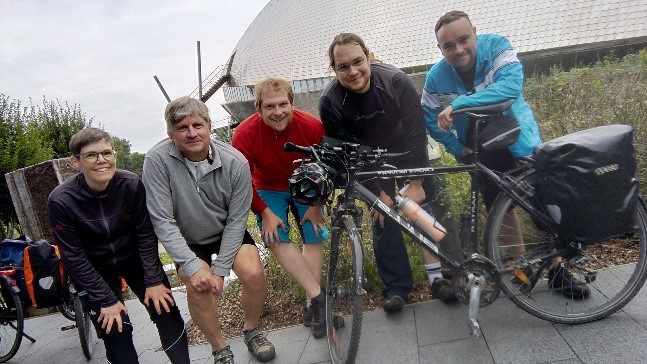
A few years ago, in the spring of 1992, at the Institute of Applied Optics at the Friedrich Alexander University of Erlangen-Nuremberg, probably during a midday coffee break, the idea was born to travel to the upcoming annual meeting of the German Society for Applied Optics in Friedrichroda, Thuringia, over Whitsun by bicycle. For the young doctoral students, who worked it out together, this seemed like an ideal opportunity to combine a visit to the annual meeting with a sporting activity. At the same time, and this was a large part of the motivation, the tour promised to at least somewhat improve the lack of knowledge about the country and its people in the neighboring state, which was still "new" after reunification.
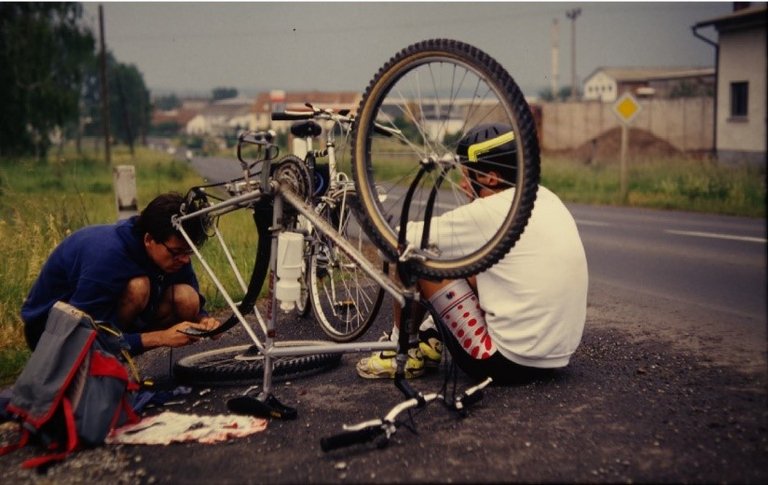
This succeeded on the tour then also in unplanned way, e.g., when on Pentecost Sunday somewhere in the Thuringian forest stranded with a broken axle in the rear wheel we had to search for help. The matter-of-factness with which the bicycle repairer, whom we had somehow found, unlocked his workshop for us on Sunday evening and repaired the wheel astonished (and delighted) us "Wessis" back in 1992. In any case, this "mother of all DGaO bike tours" has left a lasting impression, which should unfold its effect more than ten years later.
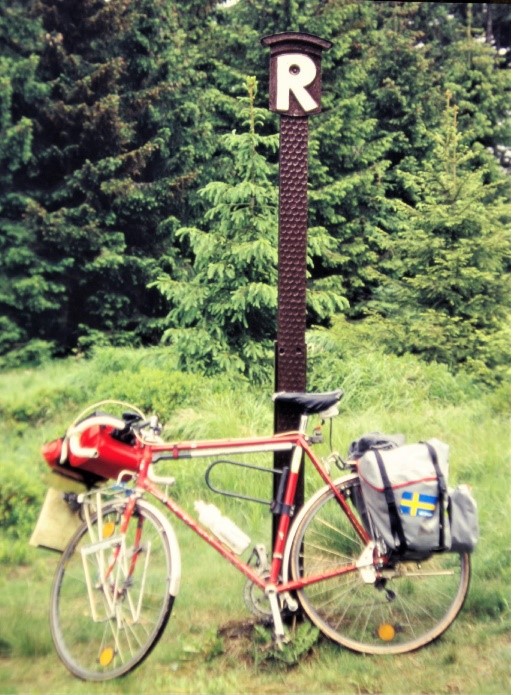
In 2005, I had meanwhile landed at Technical Optics Group at the TU Ilmenau via a few professional stations, and the topic of bicycle tours came up again with a doctoral student. The annual meeting in Wroclaw was coming up - at first glance much too far, but why not tackle it? About the fact that it was this tour, on which we, broke off and got on the train after it had poured with rain several times, I would like to spread the cloak of silence. Today - ithis often goes through my mind - this would not happen to me. Nevertheless, an idea was born, which we have kept up until today with only one exception, and the proof is there: from Ilmenau in the green heart of Germany, every DGaO meeting location can be reached by bicycle over the long Whitsun weekend.
The following year, 2006, the meeting in Weingarten was on the agenda. This tour also had something special: it is still the only one to which all then current doctoral students have joined. I did not have the perseverance to establish the bike tour participation as a mandatory part of the doctoral education at the Technical Optics Group. But I can assure you with a wink that the moral pressure in this direction is quite considerable.
How big the motivation was not to let the series started with Wroclaw, Weingarten and Heringsdorf break off, can be seen in the tour 2008 to Esslingen. On the Friday before the Whitsun weekend, the message came in that on the following Wednesday, i.e. the first day of the conference, there would be a project meeting in Jena that could not be postponed - without a chance to excuse my participation. What to do? Arrive one day later, but then what about the bike tour? The chosen solution was quite simple: we arrived in Esslingen by bike as planned and I had to skip the first day of the conference in order to get to Jena in time for the project meeting early in the morning with the borrowed car (not everything we did was based solely on ecological idealism).
And then came the real loser: Brescia. After much deliberation, it was simply too far and too difficult organizationally. The fact that we didn't even try to get to Brescia by bike gnaws at me a bit. Considering the fact that we did not shy away from tackling several tours with distances well over 600km (Brno, Heringsdorf, Eindhoven), one may ask why then not Brescia with around 900km. Some PhD students spent the Whitsun weekend 2009 as an alternative with spectacular mountain bike tours at Lake Garda, but I dropped out.
It is certainly not difficult to believe that the total of about 6000 km in the bicycle saddle on the way to the DGaO meeting, which have accumulated over the years, have been accompanied by some special experiences. The respective fellow riders can give a full-length account here. This report is not suitable to tell the numerous unique experiences even approximately comprehensively (local history and teambuilding in pure culture): Nevertheless, a few anecdotes may serve as examples.
In a special way in my memory remained so many "interesting" quarters, from youth hostels, inns in the Czech Republic, hostels with family connection and wine tasting from the family winery to the adventurous "hut" in the vineyard in the middle of the wine mile near Bad Kösen.
"The weather didn't stop us"
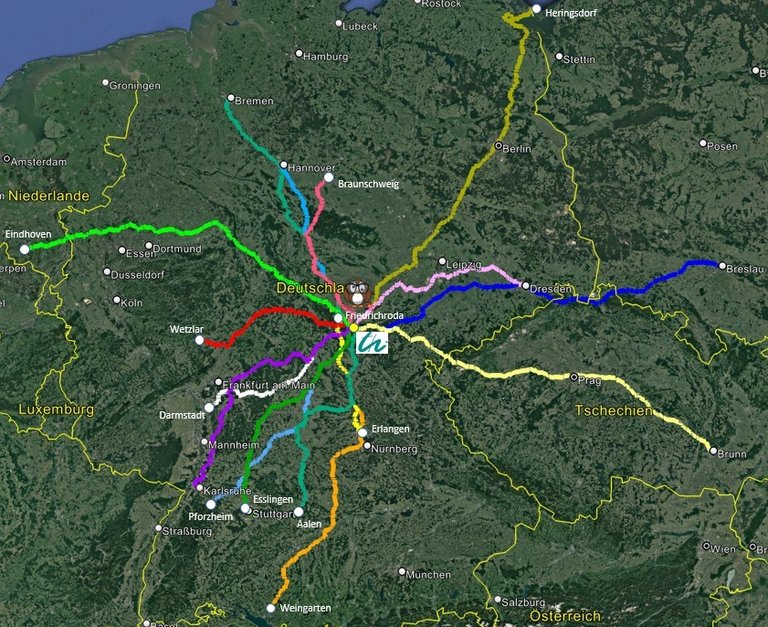
It may be hard to imagine for some fresh air muffle, but the weather did not stop us, with that single exception on the way to Wroclaw. Of course, some adaptation and good clothing is helpful here, not to say necessary. After Weingarten , I rode the entire distance with gloves against the cold - and still froze. After Karlsruhe, on the other hand, we had to extend our lunch breaks considerably due to the mighty heat and take a "siesta" in the shade. The Pizza Diavola is me at that time with the heat not at all get.... Also the trip to Esslingen was sun intensive. On this occasion, a fellow passenger had to make the experience that the "after-sun" lotion applied intensively during the day could not prevent the sunburn after all. On the other hand, how wonderful the sun's rays were in Leipzig on the way to Dresden, after half a day in the pouring rain, when our clothes so slowly began to dry again.
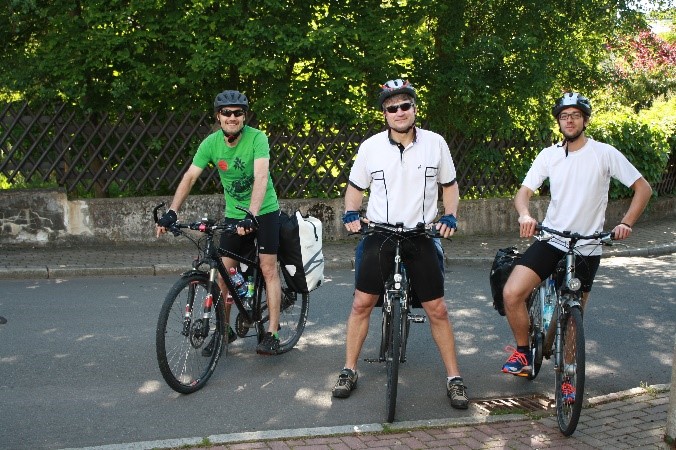
The real enemy of the cyclist, however, is the wind, especially when it comes from the front. Some situations come to mind, for example when we had to fight our way through the Thuringian basin with a fierce headwind and the smell of strawberries, presumably on the way to Braunschweig. Here, too, experience brings the solution: look for the slipstream behind the broad cross of a doctoral student, a recipe that proves itself time and again. It is only even better if one flies along with a tailwind, as for example from Bamberg to Forchheim, in the evening of the first day to Weigarten - today's electric motors are nothing compared to this.
Keyword nutrition: The liter consumption/100km is quite considerable on such bike tours and exceeds the consumption of an SUV many times. However, the liquid supplied may be much more climate-friendly. In the evening of the second day on the way to Heringsdorf (Weimar-Bitterfeld) I had estimated on the basis of the frequency with which the water bottles had to be filled, that I had "consumed" about 17 liters - well, it was a hot day and an ambitious route.
And in the evening it is allowed to feast with the best conscience. Sometimes compromises have to be made, like in Prenzlau, where we had to eat snails because a fellow rider had gotten a flat tire on a snail during the day - revenge! That was the day when we constantly had repair breaks because all fellow drivers had to go through a flat tire one after the other.
And here are some wisdoms that you also learn on such tours:
- If the Coke in your saddlebag leaks, it doesn't help that it's 100% waterproof!
- Wind turbines are usually located at the highest points of the mountains / hills. Ergo, a route plan that passes by the base of every single wind turbine may not be ideal!
- Pileated woodpeckers sitting on the side of the road can be dangerous if they fly startled directly into the spokes of the front wheel.
- When driving through watercourses, special care is required, you are in it faster than you think - I know that since the ride to Brno!
Finally, I would like to thank you from the bottom of my heart for the fact that so many people came along. I often threatened that I would go alone, but I never had to do it and it would have been only half the fun. There have always been passengers, whether voluntarily or forced, we leave undecided. Despite the fact that from time to time "outsiders" joined the trip, it never became the "Optik-Sternfahrt" that I had in mind, but that can still happen.
Also the logistic support, which we experienced again and again, should not remain unmentioned. We are infinitely grateful to the colleagues who have always transported our conference luggage to the conference venue. The jacket would certainly not have survived the ordeal of being transported in a bicycle bag so well.
Everyone helped to ensure that we always arrived in good health, essentially. With the occasional release of adrenaline, dopamine or other happy hormones, that's not necessarily a given! The most violent resulting accident then also resulted in an uncomfortably bruised arm, but fortunately nothing worse.
I would like to thank the regular riders who have ensured the continuity of the event. But at least as much I am always happy about the "first-time" tour riders, who sometimes have to grit their teeth even more than the others to get through the long tours. I hope we can keep going for a few more years and do some nice tours together. And we are happy about every fellow rider.
Personal details:
Stefan Sinzinger studied physics at the Friedrich-Alexander University of Erlangen-Nuremberg from 1983-89. With his diploma thesis at the Institute of Applied Optics of Prof. Adolf Lohmann in 1988 he started his more intensive concentration on topics of applied and physical optics. During his doctoral studies, he spent a 9-month research stay at the NEC Research Institute in Princeton, New Jersey, USA, in 1991. In 1993, he received his PhD with a thesis on three-dimensional microintegration of optical systems. From 1994 -2002 he worked as a research assistant and senior engineer at the Department of Optical Communication Technology of Prof. Jürgen Jahns at the Fernuniversität Hagen. Since 2002 he is head of the department of technical optics in the faculty of mechanical engineering at the Ilmenau University of Technology. Since 2011, together with Roman Kleindienst, he has been running Ilmenau Optics Solutions GmbH as a spin-off from the department. Stefan Sinzinger's first months at the Institute of Applied Optics in Erlangen in 1988 also marked the beginning of his active participation in the annual meetings of the DGaO. Especially as head of the department in Ilmenau, the society with its annual meetings became something like the scientific home for him and the entire field. In 2010/2011 he was a member of the board of directors as conference manager for the conference in Ilmenau. At the Hanover meeting, Stefan Sinzinger was elected chairman of the board of the German Society for Applied Optics. In 2018 at the DGaO annual meeting, he was re-elected and served as chairman of the board of the DGaO until 2021. Since 2021, Prof. Sinzinger has been vice president for research and young scientists at the TU Ilmenau. |

